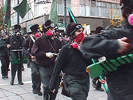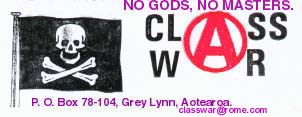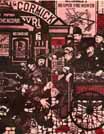 |

|
 |
CLASS WAR May Day.
|
More Mayday sites:
Police
attack workers, 4th May 1886
World War I – what was it really all about, and WHY? Poster,
3rd May 1886 |
In 1886, two anarchists, Lucy and Albert Parsons, walked arm in arm with their children down Chicago's Michigan Avenue. They walked at the head of 80,000 workers in the world's first ever May Day parade. At that moment, over 340,000 workers across the USA went on strike in support of the 8-hour day. The next day, Chicago police attacked peaceful strikers with guns and clubs, killing and wounding several. On May 3rd, Chicago anarchists led 6,000 striking lumberworkers to the aid of strikers at the McCormick Machine Co (now called International Harvester). Again the police attacked with no provocation, and again several strikers were killed or wounded. Outraged, the anarchists called a protest meeting for the next day at the Haymarket, urging workers to come armed. The meeting was peaceful, and a shower of rain sent away a lot of the crowd. When only 200 remained, the police suddenly attacked. In the confusion, a bomb sailed through the air, and exploded among the police, killing one and wounding seventy. In reply, the police opened fire, killing four and wounding others. In the hysterical aftermath, there were many calls in the mainstream media for the "violent handling of all anarchists and other such traitors". One description of anarchists was "... long haired, wild eyed, bad smelling, atheistic, reckless foreign wretches, who never did an honest hour's work in their lives, but who, driven half-crazy with years of oppression (before coming to the Land of the Free) and mad with envy of the rich..." 

Two of the martyrs of Haymarket. Michael Schwab (left) was not even at the meeting when the bomb was thrown. He left before the speakers began to go and address a rally at the Deering Reaper Works In the days that followed, eight anarchists were arrested and charged in relation to the bomb. Five were sentenced to hang, and the other three received prison sentences. On November 11, 1886, Parsons, Spies, Fischer and Engel were hung. Ling had committed suicide in his cell the night before, rather than allow the State to take his life. It has never been discovered who threw the bomb at the police, but it was certainly not any of the eight convicted for it: six of them were not even there at the time! Six years later, the State Governor released the three survivors from jail, admitting that there had never been any evidence to show they were guilty, or the other five. |
For better impact at Mayday and other protests, learn
our song: THE
BLACK FLAG.






